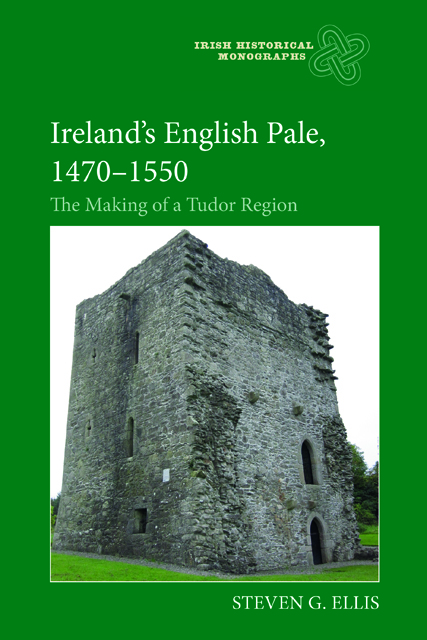Book contents
- Frontmatter
- Contents
- List of Maps
- Preface
- List of Abbreviations
- Introduction: in search of Ireland's English Pale
- 1 The horizons of English rule: retreat and recovery
- 2 The fortifications and identity of a military frontier
- 3 County Dublin and the military frontier
- 4 Strengthening the march in County Kildare
- 5 The English Pale's westward expansion: County Meath
- 6 The English Pale's northern frontier: County Louth
- 7 Restoring the English Pale, 1534-41
- 8 The waning of the English Pale
- Conclusion: an English region in Tudor Ireland
- Bibliography
- Index
- Irish Historical Monographs previous volumes
Conclusion: an English region in Tudor Ireland
Published online by Cambridge University Press: 09 January 2024
- Frontmatter
- Contents
- List of Maps
- Preface
- List of Abbreviations
- Introduction: in search of Ireland's English Pale
- 1 The horizons of English rule: retreat and recovery
- 2 The fortifications and identity of a military frontier
- 3 County Dublin and the military frontier
- 4 Strengthening the march in County Kildare
- 5 The English Pale's westward expansion: County Meath
- 6 The English Pale's northern frontier: County Louth
- 7 Restoring the English Pale, 1534-41
- 8 The waning of the English Pale
- Conclusion: an English region in Tudor Ireland
- Bibliography
- Index
- Irish Historical Monographs previous volumes
Summary
That Ireland’s English Pale was named after its French counterpart, the English Pale at Calais, has long been recognized, but its first naming turns out to have been a Tudor development, reflecting the association with both territories of Henry Tudor’s best-remembered chief governor of Ireland, Sir Edward Poynings. In 1494 Poynings was redeployed as deputy-lieutenant of Ireland from his previous posting as deputy-lieutenant of Calais. This first naming of Ireland’s English Pale in a statute of Poynings’ parliament was among the longer-lasting but largely unintended accomplishments of the Poynings regime, not unlike the same parliament’s enactment of Poynings’ Law. which lasted until 1782. The chance discovery of Poynings’ role in naming the English Pale has, however, shone new light on the context and chronology of the early development of the Pale, pointing to the role of the Kildare earls as chief governor. This is among the few major correctives about the Pale’s development that must be made to Professor James Lydon’s seminal paper about ‘The problem of the frontier in medieval Ireland’. Otherwise, it is remarkable how well Lydon’s pioneering essay has stood the test of time. Despite the growing literature on the Pale’s origins and development, its geographical extent, and the location and character of its standing defences, recent studies have still largely followed Lydon’s pioneering survey. They have reflected his earlier insights about the contracting area of English rule, a frontier strategy of keeping apart Ireland’s English and Irish nations by ‘a policy of racial segregation’ and ‘driving a cultural barrier’ between them, and they even follow Lydon’s final verdict on this frontier strategy as ‘a complete failure’. Related studies about cross-border migration, intermar¬riage, and acculturation in the Pale region have also called into question the effectiveness of the Pale’s frontiers in halting medieval English decline and preserving the English character and culture of the colonial parts.
The present study has offered a critical review of these insights into the origins and development of the English Pale. Its basic argument is that the creation of Ireland’s English Pale marked a major change in the earlier frontier strategy of keeping English and Irish apart. The military frontier erected around the Pale was essentially a new strategy, which accorded with the growing desire of early modern kings to establish more clearly defined limits for their multiple monarchies.
- Type
- Chapter
- Information
- Ireland's English Pale, 1470-1550The Making of a Tudor Region, pp. 169 - 174Publisher: Boydell & BrewerPrint publication year: 2021



